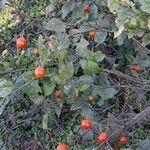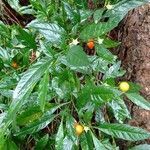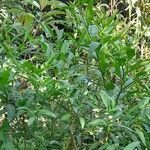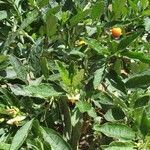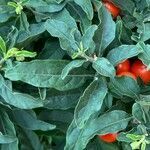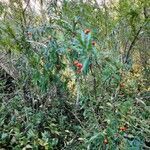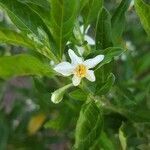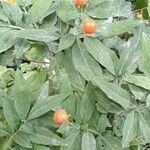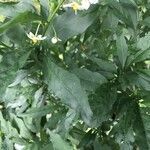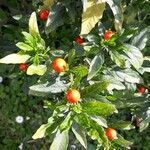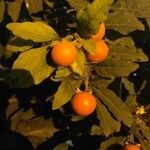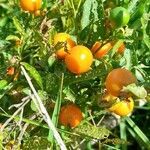Erect, unarmed shrub, glabrous or sometimes with few-branched hairs on very young shoots; stems wiry, 40-120-(200) cm tall. Petiole to 2 cm long, slender. Lamina 3-12 × 1-3 cm, lanceolate or elliptic-lanceolate, glossy above; margins usually undulate; base narrowly attenuate; apex obtuse or acute. Fls 1-several; peduncle 0-8 mm long; pedicels 5-10 mm long, erect at fruiting. Calyx 4-5 mm long; lobes lanceolate to ovate, slightly accrescent. Corolla c. 15 mm diam., white, glabrous; lobes oblong-ovate to ± triangular. Anthers 2.5-3 mm long. Berry 1.5-2 cm diam., globose, glossy, orange to scarlet, long-persistent; stone cells 0. Seeds c. 3 mm diam., suborbicular to reniform or obovoid, rather asymmetric; margin thickened.
Shrubs erect, branched, unarmed; pubescence of simple and branched hairs. Petiole 2-5 mm; leaf blade narrowly oblong to lanceolate, 1-6 × 0.5-1.5 cm, pubescent or glabrous, base cuneate, decurrent, margin entire or sinuate, apex acute or obtuse. Inflorescences leaf opposed or extra-axillary, solitary or rarely paired flowers or short racemes; peduncle short or obsolete. Pedicel 3-4 mm. Calyx green, ca. 4 mm in diam., prominently lobed; lobes ca. 1.5 mm. Corolla white or mauve, 0.8-1.5 cm in diam., lobed about half way. Filaments less than 1 mm, glabrous; anthers ca. 2 mm. Style ca. 2 mm. Fruiting pedicel ca. 1 cm, expanded at apex. Berry orange-red, fleshy, 1.2-1.5(-2) cm in diam. Seeds discoid, 2-3 mm in diam.
Unarmed shrub, up to 2 m high, ± glabrous, young stems green. Leaves lanceolate, up to 105 x 18 mm, subentire or repand, decurrent at base, paler green below, midrib prominent below; petioles up to 10 mm long. Inflorescence lateral, ± sessile, 1-5-flowered; pedicels ± 8 mm long. Calyx campanulate, up to 6 mm long, deeply lobed, lobes linear-lanceolate; later larger. Corolla rotate-stellate, 10-15 mm in diam., deeply lobed, lobes broad, up to 5 mm long, white. Flowering time Oct.-Mar. Fruit globose, shiny, 10-15 mm in diam., bright orange-red, fleshy. Seeds lenticular, compressed, shiny, 3-4 mm long, ± yellow.
Shrub to 2 m high, green, glabrous or sparsely pubescent on young twigs and new growth; prickles absent. Leaves oblong-lanceolate; lamina 4–10 cm long, 1–3 cm wide, concolorous, slightly undulate; petiole 5–15 mm long. Inflorescence short, 1–several–flowered; peduncle absent or up to 1 cm long; pedicels c. 1 cm long. Calyx 4–5 mm long; lobes narrowly triangular, 2–3 mm long. Corolla deeply stellate, 10–15 mm diam., white. Anthers 2–3 mm long. Berry globular, 10–15 mm diam., bright orange-red. Seeds 3–4 mm long, pale buff or yellow, the margin thickened.
Shrub, up to 2.5 m high; short-lived. Spines absent. Leaves subsessile; blade decurrent, obovate-elliptic, up to 140 x 20 mm, apex rounded, base cuneate, margins entire or slightly and distantly scalloped, ± glabrous. Flowers: in few-flowered, lateral, umbellate cymes, or sometimes solitary; corolla 10 mm in diameter, white; Oct.-May. Fruit a green to orange to bright red berry, ± 15 mm in diameter.
Small, much branched shrub, tomentose with simple and forked hairs on young branches; leaves in pairs, one smaller, 4-7(9) x 2-3(4.5) cm, narrowly elliptic to elliptic, entire to somewhat undulate, glabrous to pubescent beneath; flowers few, on racemiform cymes, or solitary; corolla white, c. 1-1.5 cm in diameter, rotate-stelliform; fruit red tinged orange or scarlet, 1-2 cm long, globose or ovoid.
An erect shrub. It grows 90-120 cm tall. The leaves are 4-8 cm long by 1-2 cm wide. They are narrowly oval. There are 1-3 flowers in a group in the axils of leaves. The flowers are white. The fruit is a berry 8-12 mm across. It is scarlet red and shiny. The seeds are 3 mm wide.
Shrub, 0.9-1.2 m high, unarmed. Leaves repand, glabrous. Cymes umbellate, few-flowered, sometimes solitary. Corolla 10 mm in diameter. Fruit red or orange-red. Flowers white.
Softly woody shrublet to 1 m. Leaves bright green, elliptic to lanceolate, to 12 cm long. Flowers 1-few in clusters, white, 5 mm diam. Berries orange-red, 10-15 mm diam.
